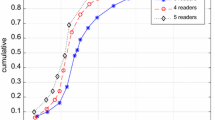Abstract
In the current (Internet of Things) trend, the identification capability of RFID is integrated for the identification and applications of all objects, and this trend reveals the future demand for RFID wireless communication and localization. Therefore, this paper investigates the influences of RSSI and the distance to RFID and analyzes the common indoor localization algorithms, including range-based algorithms and range-free algorithms. However, there are too many interference factors in the indoor environment that easily lead to localization inaccuracy. To improve the RF-mapping technique in RFID that requires much time for initiation and lots of calculations, this paper proposes a GA-based (Genetic Algorithms, GA) localization algorithm to estimate the locations of unknown nodes and avoid the influence of environmental factors by pre-establishing the pattern. The designed scenarios and reference nodes in this paper are used to train our proposed algorithm and obtain the patents of the scenarios, which are adopted for RFID nodes to further compare and decrease errors. Therefore, as long as the algorithm is trained in advance with the scenarios and then include the patents in the new environment, the errors and the training time can be greatly reduced. Moreover, our proposed algorithm needs only little information about reference nodes to pre-establish the pattern.




















Similar content being viewed by others
References
Gao J, Liu F, Ning H, Wang B (2007) RFID coding, name and information service for internet of things. In: Proceeding of the IET comunication conference on wireless, mobile sensor networks (CCWMSN07), pp 36–39
Michael MP, Darianian M (2008) Architectural solutions for mobile RFID services for the internet of things. In: Proceedings of the 2008 EEE congress on services—part I, pp 71–74
Zhang T, Wang X, Chu J, Liu X, Cui P (2010) Automotive recycling information management based on the internet of things and RFID technology. In: Proceedings of the 2010 IEEE international conference on advanced management science (ICAMS), pp 620–622
Yan B, Huang G (2009) Supply chain information transmission based on RFID and internet of things. In: Proceedings of the ISECS international colloquium on computing, communication, control, and management (CCCM), pp 166–169
Enge P, Misra P (1999) Special issue on GPS: the global positioning systems. Proc IEEE 87:3–172
Garcia M, Martinez C, Tomas J, Lloret J (2007) Wireless sensors self-location in an indoor WLAN environment. In: Proceedings of the 2007 international conference on sensor technologies and applications (SENSORCOMM), pp 146–151
Ciurana M, Barcelo-Arroyo F, Izquierdo F (2007) A ranging method with IEEE 802.11 data frames for indoor localization. In: Proceedings of the IEEE wireless communications and networking conference (WCNC), pp 2092–2096
El Moutia A, Makki K (2008) Time and power based positioning scheme for indoor location aware services. In: Proceeding of the 5th IEEE computer communication networking conference (CCNC), pp 868–872
Andersen JB, Rappaport TS, Yoshida S (1995) Propagation measurements and models for wireless communications channels. IEEE Commun Mag 33:42–49
Rappaport TS (2002) Wireless communications principles and practice. Prentice-Hall, New Jersey
Ji W-W, Liu Z (2006) An improvement of DV-hop algorithm in wireless sensor networks. In: International conference on wireless communications, networking and mobile computing 2006. WiCom 2006, 22–24 Sept 2006, pp 1–4. doi:10.1109/WiCOM.2006.257
Sarkar TK, Zhong J, Kyungjung K, Medouri A, Salazar-Palma M (2003) A survey of various propagation models for mobile communication. IEEE Antennas Propag Mag 45:51–82
Emery M, Denko MK (2007) IEEE 802.11 WLAN based real-time location tracking in indoor and outdoor environments. In: Proceedings of the Canadian conference on electrical and computer engineering (CCECE), pp 1062–1065
Whitehouse K, Karlof C, Culler D (2007) A practical evaluation of radio signal strength for ranging-based localization. ACM SIGMOBILE Mob Comput Commun Rev 11:41–52
Bahl P, Padmanabhan VN (2000) RADAR: an in-building RF-based user location and tracking system. In: Proceedings IEEE. INFOCOM 2000. Nineteenth annual joint conference of the IEEE computer and communications societies, vol 2, pp 775–784
Yedavalli K, Krishnamachari B, Ravula S, Srinivasan B (2005) Ecolocation: a sequence based technique for RF localization in wireless sensor networks. In: Proceedings of the 4th international symposium on information processing in sensor network (IPSN’05), pp 285–292
Niculescu D, Nath B (2003) DV based positioning in ad hoc networks. J Telecommun Syst 22:267–280
Lim H, Kung LC, Hou JC, Luo L (2006) Zero-configuration, robust indoor localization: theory and experimentation. In: Proceedings of the 25th IEEE international conference on computer communications (INFOCOM), pp 1–12
Juang JH, Weng TK, Cuong PV, Hsu CY, Lee YH, Su SH (2008) Experimental assessment of wireless sensor network localization techniques. In: Proceedings of the 10th international conference on control, automation, robotics and vision (ICARCV), pp 335–340
Ali A, Nobles P (2007) A novel indoor location sensing mechanism for IEEE 802.11 b/g wireless LAN. In: Proceedings of the 4th workshop on positioning, navigation and communication (WPNC ‘07), pp 9–15
Goldberg DE (1989) Genetic algorithms in search, optimization, and machine learning. Addison, Wesley
Negnevitsky M (2004) Artificial intelligence. A guide to intelligent systems, 2nd edn. Addison-Wesley
Zhang Q, Wang J, Jin C, Ye J, Ma C, Zhang W (2008) Genetic algorithm based wireless sensor network localization. In: Proceedings of the 2008 4th international conference on natural computation, pp 608–613
Acknowledgments
This study was sponsored by the National Science Council, Taiwan, under grant no. NSC-99-2221-E-032-040. The authors’ gratitude also goes to Ying-Yu Wei for providing brilliant and helpful opinions about several issues of this paper.
Author information
Authors and Affiliations
Corresponding author
Rights and permissions
About this article
Cite this article
Wu, TY., Liaw, GH., Huang, SW. et al. A GA-based mobile RFID localization scheme for internet of things. Pers Ubiquit Comput 16, 245–258 (2012). https://doi.org/10.1007/s00779-011-0398-9
Received:
Accepted:
Published:
Issue Date:
DOI: https://doi.org/10.1007/s00779-011-0398-9




